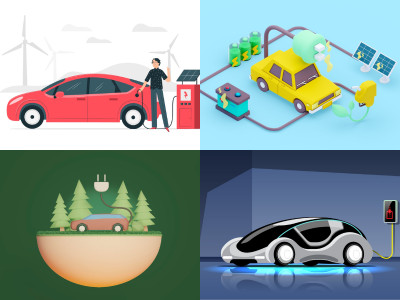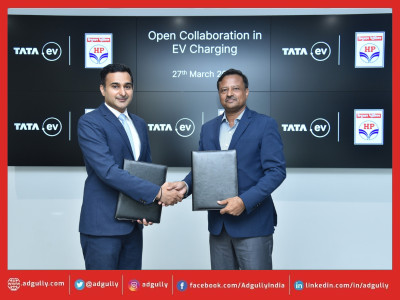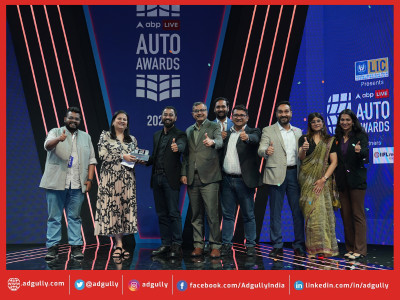A deep dive into India’s EV ecosystem – The challenges and the green road ahead
Electrification of vehicles in India is still at a nascent stage compared to countries such as Norway and China. While the four-wheeler electrification has been slow, the spotlight of the consumer EV revolution in the country is on two-wheelers (2W) at the moment. Ownership cost savings of electric 2W ranging from 20-70% over petrol 2Ws have piqued the interest of the average buyer, while the B2B players have already jumped on the opportunity, as per a Redseer study.
According to the Economic Survey 2023, India’s domestic electric vehicle market is projected to see a CAGR growth of 49% between 2022 and 2030, with annual sales pegged at 10 million by 2030. Meanwhile, as per Fortune Business Insights, the electric vehicle market in India is expected to grow from $3.21 billion in 2022 to $113.99 billion by 2029 – a CAGR of 66.52%.
As per Federation of Automobile Dealers Associations’ (FADA) data, EV sales saw a 155% YoY growth between FY20 and FY22 to 429,217 units in FY22. Despite the recent slump in EV sales, a global pandemic, and worries of a slowdown, this upward trend in the numbers doesn’t seem to be slowing down.
The green road ahead
Gunjan Malhotra, Director, Komaki Electric Division, noted, “With the country’s outlook for a sustainable economic growth, the clean mobility industry in the country has witnessed exponential growth in the recent years. The sale of the electric vehicles has witnessed a surge – more than 2,218 per cent growth is registered over the past three years, while over 442,901 electric cars have been sold in FY 2022-23 (till December 9), as compared to 19,100 sold in FY 2020. These promising figures have also opened doors for massive investment opportunities in the clean mobility segment of the country.”
Malhotra further said that viewing the huge opportunity the EV industry offing, many leading players, including start-ups, have put a renewed focus on the clean mobility market. Industry players have also been focused on creating a robust charging infrastructure in India, with states like Andhra Pradesh, Uttar Pradesh, Bihar, and Telangana having set impressive targets for the deployment of public charging infrastructure to increase uptake of electric vehicles.
In her Budget 2023 speech, Finance Minister Nirmala Sitharaman made the announcement that electric vehicles (EVs) manufacturing can become more affordable in India by extending the subsidies on their batteries for another year. She suggested extending the reduced duty on lithium-ion batteries by another year.
In May 2021, the government unveiled the Production Linked Incentive (PLI) program for the manufacture of batteries. This vital element of electric vehicles will cost less, thanks to the PLI initiative. Sales of electric vehicles now only incur a 5% Goods and Services Tax (GST), down from 12% previously.
One of the top 7 priorities in the Union Budget 2023 was green growth. The Pro-EV budget puts a lot of emphasis on important initiatives, like reducing the customs charge on lithium batteries from 21% to 13% and prolonging the subsidies for EV batteries by another year. They are beneficial actions since they will contribute to a rise in demand.
The government's commitment to promoting environmental sustainability and the budget's goal of encouraging eco-conscious lifestyles are both supported by the policy on replacing old, polluting vehicles, which should hasten the switch to electric vehicles, as highlighted by the Finance Minister in Union Budget 2023.
Besides the vehicle scrappage policy announced in Budget 2021–22, additional funds have been allocated to support efforts to scrap old vehicles under central government control. Additionally, states will receive funds to dispose of outdated cars and ambulances.
Adoption of EVs
Globally, companies like Tesla, Nissan, and Chevrolet have been leading the way in the production of electric cars, even as governments around the world have been offering incentives and subsidies to encourage consumers to switch to EVs.
India is the world’s largest two-wheeler (2W) market, with an estimated 375-400 million 2Ws on the road. According to the latest report by Redseer Strategy Consultants, the electric 2W market is expected to be over 80% of the overall 2W market by 2030. Redseer projects that E2W sales volume in India is expected to reach ~22 million by 2030.
According to the report, one of the critical drivers of growth is the rise of numerous brands in the E2W space, such as Ather, Ola, Hero Electric, Bajaj, TVS, Okinawa, PUREV, and Revolt. As a result, consumers have more options, pushing better adoption across price points and improving trust among the masses. As a result, E2W sales across India are on the rise, including in Tier 3 and Tier 4+ cities.
Komaki Electric Division’s Gunjan Malhotra projected, “If India continues its steady progress towards meeting its 2030 targets, the EV market in the country will have $206 billion worth by 2030. It is also projected that the EV market in the country will be growing at a compound annual growth rate (CAGR) of 36 per cent till 2026 and at a CAGR of 49 per cent in the 2022-2030 period.”
According to Malhotra, for a faster adoption of the electric vehicles, India should ensure that certain key issues are being addressed effectively like upgradation to new components manufacturing through restructuring, electronic components manufacturing and sourcing, rapid infrastructure development for charging, government incentives for EVs as a preferred category, and content feeding to public for building image and relevance of EVs towards a sustainable future.
Alapati Krishna Mohan, MD, Southern Travels, added here, “In recent years, we have seen a significant increase in the popularity of EV vehicles. We believe one of the main factors contributing to the growth is increasing awareness of the environmental impact of traditional gasoline-powered vehicles. People are becoming more conscious of the need to reduce carbon emissions and protect the planet, and EV vehicles provide a solution to this issue.”
“While the world is transforming itself towards a sustainable future, there has been a renewed focus on electrifying the mobility sector. India's diligent efforts in pioneering and achieving 50 per cent of its total energy from renewable resources by 2030 and accomplishing net-zero emissions by 2070, will commence on the journey of clean and green mobility which has mostly been driven by high fuel prices and the country's sagacious efforts to meet its commitment to reduce the overall carbon footprint.” he further added.
Building Trust
According to Malhotra “Clean mobility has emerged as a newest trend in the automobile sector, with most new players in the industry being more focused on the EVs in the recent years. The huge prospects for opportunity that the EV sector offers have encouraged the pre-existing brands in the sector, which were earlier mostly manufacturing Internal Combustion Engines (ICE) powered vehicles, to gradually shift their focus towards electric vehicles. Original equipment manufacturers (OEMs) in the automobile industry – both start-ups and the established manufacturers are now in the endeavour to deliver their best to help the country meet its ambitious target of 100 per cent electrification by 2030. New brands in the industry like us, the vision is to replace all fossil fuel-based vehicles in the country with E-vehicles and create a cleaner, greener India. Komaki, in just four years of existence, has established a strong network of 300+ dealership stores pan-India. Komaki has the widest range of electric 2 wheelers, with 11 CMVR exempt models and 6 high-speed registration models.”
In order to build trust among the consumers, the marketers are highlighting the environment friendly and cost effective features of RVs. Krishna Mohan pointed out, “In India, the state governments have been actively promoting the adoption of EV vehicles through a range of incentives and policy measures. These include subsidies on EV purchases, tax exemptions, and the creation of charging infrastructure across the country. These measures have made EV vehicles more accessible and affordable for consumers in India, which has contributed to the growth of the EV market in the country.”
“In terms of cost-effectiveness, while EV vehicles may have a higher upfront cost compared to traditional gasoline-powered vehicles, they offer significant long-term savings and a comparatively far lesser effective cost. EV vehicles have lower operating costs due to lower maintenance and fuel costs. In addition, with the continued development of battery technology, we expect the cost of EV vehicles to decrease further in the future.” he further added.
Varun Goenka, Founder and CEO, Chargeup, too, pointed out that that there is tremendous consumer interest in EVs. India being one of the largest automobile markets globally, it provides ample opportunity for growth. At the same time, he also highlighted the challenges that have made most consumers adopt a ‘wait and watch’ approach. According to Goenka, “The biggest concern is about the operating range of vehicles. Once the battery is depleted, the vehicle needs to be put on charging for hours, leading to low mobility. That’s where adoption can be boosted by the expansion of battery swapping services that facilitate the replacement of drained batteries with fully-charged ones in a matter of minutes. This would eliminate range anxiety and enable more people to choose EVs confidently.”
“Second, the battery-swapping ecosystem can also help reduce the cost of EVs which is the other major barrier. Companies like Chargeup offer subscription services wherein people can buy EVs at a much lower rate without the batteries and subscribe to our battery-swapping solutions. This frees them from the burden of buying, charging, and maintaining the batteries. It is the adoption of such advanced tech-driven and consumer-friendly innovative services that are also going to drive the overall EV adoption in the times ahead.” he added.
Key challenges
One of the major challenges when it comes to Electric Vehicle is the charging stations.
“Like any other technological application, Electric Vehicle charging stations are also susceptible to cyber-attacks and cyber security incidents. The Government is fully cognizant and aware of various cyber security threats and is actively taking steps to combat the issue of hacking. In the recently notified cyber security direction, CERT-In has now made it mandatory for all incidents to be mandatorily reported to CERT-In. CERT-In has formulated a Cyber Crisis Management Plan for countering cyber-attacks and cyber terrorism for implementation by all Ministries and Departments of the Central Government, State Governments, and their organisations and critical sectors,” Union Minister for Road Transport and Highways, Nitin Gadkari, acknowledged in a written reply in the Lok Sabha.
Another issue while traveling in EV is definitely the lesser number of charging stations in Tier 2 and Tier 3 areas. According to Varun Goenka, “Battery swapping can eliminate the need for spending long hours on charging which is the major drawback that holds commercial vehicle users from switching to EVs. Further, this can help eliminate range anxiety, which is a common concern among EV drivers who worry about running out of battery power before reaching their destination. Through battery swapping, instead of waiting for the battery to charge, which can take hours, EV drivers can exchange their depleted battery for a fully charged one in just a few minutes. Also, EV batteries cost nearly one-third or more of an EV’s cost, which makes purchasing and owning these vehicles costlier than conventional ICE vehicles.”
Tushar Choudhary, CEO, Motovolt, noted, “Current and upcoming giga factories should be able to meet the overall demand. However battery cell manufacturing in India is being processed. Motovolt products come with removable batteries which makes consumer adoption independent of charging infrastructure.”
Brand Communication
With the growing market for electric cars, electric vehicle marketing is becoming a key focus for many automobile marketers. Electric vehicle marketers invest heavily in advertising and promoting their vehicles, as well as developing new marketing strategies to reach different segments of consumers.
Emphasising on the environmental advantages of electric vehicles is one of the primary strategies used by auto marketers to promote them. This includes emphasising the fact that electric cars have no emissions and can aid in lowering greenhouse gas emissions and air pollution. Several auto marketers also emphasise the financial benefits of electric vehicles, such as cheaper gasoline and maintenance costs.
Car marketers are also promoting their electric automobiles through a variety of marketing platforms. This covers influencer marketing and social media in addition to more modern forms of advertising like TV, print, and online advertising. Automobile marketers are now making use of occasions like auto exhibitions and test drives to advertise their electric automobiles and provide customers a chance to see them in action.


















Share
Facebook
YouTube
Tweet
Twitter
LinkedIn